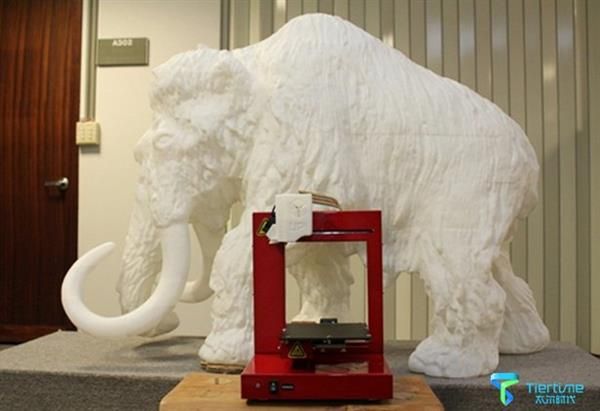Taiwan's National Science & Tech Museum 3D prints a 197-piece Woolly Mammoth statue

We recently reported on a very interesting way to save Rhinos from extinction by 3D printing biological replicas of Rhino horns, but one Taiwanese museum is using 3D printing technology to even breathe new life into the woolly mammoth. The Taiwanese National Science & Technology Museumcommissioned the 3D printing of a gigantic statue of this majestic beast as a center piece for the exhibition ‘Journey of Printing Collections’, which was made with a desktop UP Plus 2 3D printer.
Now as you might know, the woolly mammoth (with the Latin name of Mammuthus primigenius), was one of the largest land mammals the world has ever seen. And remarkably, they coexisted alongside humans for thousands of years. Capable of reacing heights of more than 11 feet and weighing up to 6 tonnes, they were absolute giants that our ancestors hunted for their meat. Scientists know quite a lot about these remarkable animals as some have been preserved frozen in ice, but we don’t know exactly why they died out. Beginning to slowly disappear about 10,000 years ago, the last population in Northeastern Russia went extinct about 4,000 years ago – much and much later than the dinosaurs (65 million years ago).
However, the woolly mammoth have been given a lot of attention recently, as their DNA is quite well preserved and scientists are even looking into cloning options for these fantastic creatures. That renewed attention was probably one of the reasons why the National Science Museum of Technology chose this animal as a centerpiece for their 3D printing exhibition. As the museum explained on their website, the curator also intended to show the history of printing technology, and what better way to capture the futuristic properties of latest developments by recreating a piece of nature’s history? ‘If all the objects in the exhibition are based on historical review, then we can begin to look toward the future,’ the curator said.
To breathe new life into a plastic version of the woolly mammoth, they teamed up with the Beijing-basedTiertime Technology, whom you might know as the manufacturers of commonly used desktop 3D printers such as the UP BOX and the UP Plus 2. Now that partnership might sound a bit strange, as the Taiwan museum was after a statue that was also of mammoth proportions. And yet, they set out to 3D print the statue (which is approximately 1 x 1 x 1 meter) with e UP Plus 2 3D printer, which unfortunately has a small building platform of just 140 x 140 x 135 mm. So how do you make this work? While you and I might break up projects into a handful of pieces, the Taiwanese museum resorted to 3D printing a mind-blowing 197 different components, or a nightmarish puzzle to assemble.

And yet, as they explain on their website, the choice was a conscious one. As the 3D printing designer in charge of the project said, detail was everything. ‘Because large objects are printed in separate pieces each print-out, whether the horizontal and vertical components, and the level of precision are very important. Just imagine how the final product would look if each part deviated just slightly from the intended goals. Not only would it look terrible, the parts would also become increasingly difficult to combine into a single sculpture.’
That is why, they say, the UP Plus 2 3D printer was chosen, for its high precision capacity and the small tolerances it has. It was also very easy to operate, staff members said. ‘Using the UP Plus 2, as long as you can execute the print command with the push of a button, you can instantly realize design ideas quickly and verify its use for your plans. It is also very easy to modify or recreate parts quickly.’ It was also, they say, relatively environmentally friendly as it hardly wastes materials.
What’s more, officials from the museum were also very pleased with the results. ‘We appreciate that 3D printing has become an accepted tool and is no longer a scientific accessory. Our approach to manufacturing has evolved and is now incorporating digital design tools. Just imagine what can be easily 3D printed; it is changing and accelerating the ways we realize our creativity, and education should be adjusted to incorporate the next generation’s production and consumption tools,’ said the museum’s director Sun Wei-hsin. And what better way to emphasize the future than through a tribute to the past?







